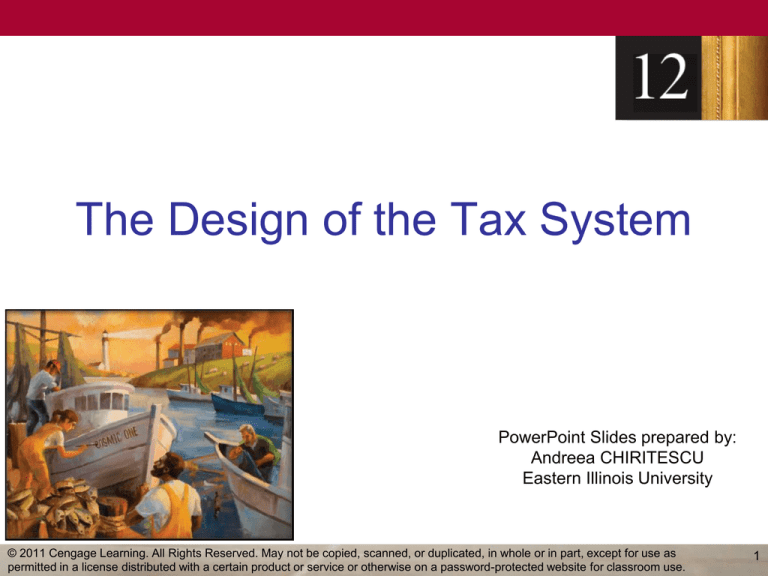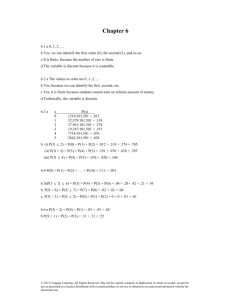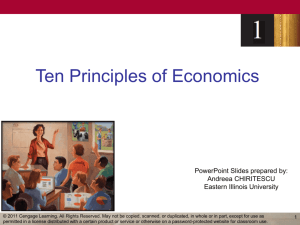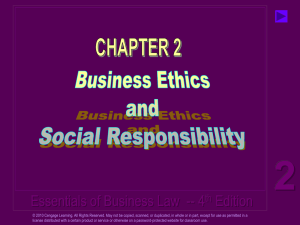
The Design of the Tax System
PowerPoint Slides prepared by:
Andreea CHIRITESCU
Eastern Illinois University
© 2011 Cengage Learning. All Rights Reserved. May not be copied, scanned, or duplicated, in whole or in part, except for use as
permitted in a license distributed with a certain product or service or otherwise on a password-protected website for classroom use.
1
Financial Overview of Government
• Government revenue - increased
– As percentage of total income
– As economy’s income has grown
• Government’s revenue from taxation has
grown even more
• As a nation gets richer
– Government - takes a larger share of
income in taxes
© 2011 Cengage Learning. All Rights Reserved. May not be copied, scanned, or duplicated, in whole or in part, except for use as
permitted in a license distributed with a certain product or service or otherwise on a password-protected website for classroom use.
2
Figure 1
Government Revenue as a Percentage of GDP
This figure shows revenue of the federal government and of state and local
governments as a percentage of gross domestic product (GDP), which measures total
income in the economy. It shows that the government plays a large role in the U.S.
economy and that its role has grown over time.
© 2011 Cengage Learning. All Rights Reserved. May not be copied, scanned, or duplicated, in whole or in part, except for use as
permitted in a license distributed with a certain product or service or otherwise on a password-protected website for classroom use.
3
Table 1
Total Government Tax Revenue as a Percentage of GDP
© 2011 Cengage Learning. All Rights Reserved. May not be copied, scanned, or duplicated, in whole or in part, except for use as
permitted in a license distributed with a certain product or service or otherwise on a password-protected website for classroom use.
4
The Federal Government
• The federal government’s receipts
– Individual income tax
• Based on total income (marginal tax rate)
– Payroll taxes - tax on wages
• “Social insurance taxes” – pay for Social
Security and Medicare
– Corporate income tax - based on profit
– Other:
• Excise tax, estate tax, custom duties
© 2011 Cengage Learning. All Rights Reserved. May not be copied, scanned, or duplicated, in whole or in part, except for use as
permitted in a license distributed with a certain product or service or otherwise on a password-protected website for classroom use.
5
Table 2
Receipts of the Federal Government: 2009
© 2011 Cengage Learning. All Rights Reserved. May not be copied, scanned, or duplicated, in whole or in part, except for use as
permitted in a license distributed with a certain product or service or otherwise on a password-protected website for classroom use.
6
Table 3
The Federal Income Tax Rates: 2010
This table shows the marginal tax rates for an unmarried taxpayer. The taxes owed by
a taxpayer depend on all the marginal tax rates up to his or her income level. For
example, a taxpayer with income of $25,000 pays 10 percent of the first $8,375 of
income, and then 15 percent of the rest.
© 2011 Cengage Learning. All Rights Reserved. May not be copied, scanned, or duplicated, in whole or in part, except for use as
permitted in a license distributed with a certain product or service or otherwise on a password-protected website for classroom use.
7
The Federal Government
• The federal government’s spending
– Social Security, 19%
• Transfer payments to the elderly
– National defense, 19%
– Income security, 15%
• Transfer payments to poor families
• Temporary Assistance for Needy Families
(TANF)
• Food Stamps
• Unemployed compensation
© 2011 Cengage Learning. All Rights Reserved. May not be copied, scanned, or duplicated, in whole or in part, except for use as
permitted in a license distributed with a certain product or service or otherwise on a password-protected website for classroom use.
8
The Federal Government
• The federal government’s spending
– Medicare
• Health plan for the elderly
– Other health spending
• Medicaid - health program for the poor
• Spending on medical research
– Net interest
© 2011 Cengage Learning. All Rights Reserved. May not be copied, scanned, or duplicated, in whole or in part, except for use as
permitted in a license distributed with a certain product or service or otherwise on a password-protected website for classroom use.
9
The Federal Government
• The federal government’s spending
– Other spending
• Federal court system
• Space program
• Farm-support programs
• Housing credit program
• Salaries of members of Congress and the
president
© 2011 Cengage Learning. All Rights Reserved. May not be copied, scanned, or duplicated, in whole or in part, except for use as
permitted in a license distributed with a certain product or service or otherwise on a password-protected website for classroom use.
10
Table 4
Spending of the Federal Government: 2009
© 2011 Cengage Learning. All Rights Reserved. May not be copied, scanned, or duplicated, in whole or in part, except for use as
permitted in a license distributed with a certain product or service or otherwise on a password-protected website for classroom use.
11
The Federal Government
• Budget deficit
– Government spending > government
receipts
– Financed - borrowing from the public
• Budget surplus
– Government receipts > government
spending
– Uses the excess receipts to reduce its
outstanding debts
© 2011 Cengage Learning. All Rights Reserved. May not be copied, scanned, or duplicated, in whole or in part, except for use as
permitted in a license distributed with a certain product or service or otherwise on a password-protected website for classroom use.
12
State and Local Government
Table 5
Receipts of State and Local Governments: 2007
© 2011 Cengage Learning. All Rights Reserved. May not be copied, scanned, or duplicated, in whole or in part, except for use as
permitted in a license distributed with a certain product or service or otherwise on a password-protected website for classroom use.
13
State and Local Government
• Spending
– Education
• Public schools: kindergarten to high school
• Public universities
– Public welfare
• Transfer payments to the poor
– Highways
• Building and maintenance of roads
© 2011 Cengage Learning. All Rights Reserved. May not be copied, scanned, or duplicated, in whole or in part, except for use as
permitted in a license distributed with a certain product or service or otherwise on a password-protected website for classroom use.
14
State and Local Government
Table 6
Spending of State and Local Governments: 2007
© 2011 Cengage Learning. All Rights Reserved. May not be copied, scanned, or duplicated, in whole or in part, except for use as
permitted in a license distributed with a certain product or service or otherwise on a password-protected website for classroom use.
15
Taxes and Efficiency
• Administrative burden
– Time spent to fill out forms
– Time spent keeping records for tax
purposes
– Resources the government use to enforce
the tax laws
– Tax lawyers and accountants
– Resources for complying with tax laws
– Can be reduced by simplifying the tax laws
• Politically difficult
© 2011 Cengage Learning. All Rights Reserved. May not be copied, scanned, or duplicated, in whole or in part, except for use as
permitted in a license distributed with a certain product or service or otherwise on a password-protected website for classroom use.
16
Taxes and Equity
• The benefits principle
– People should pay taxes based on the
benefits they receive from government
services (e.g., toll roads, vehicle
registration, property tax)
• The ability-to-pay principle
– Taxes should be levied on a person
according to how well that person can
shoulder the burden
© 2011 Cengage Learning. All Rights Reserved. May not be copied, scanned, or duplicated, in whole or in part, except for use as
permitted in a license distributed with a certain product or service or otherwise on a password-protected website for classroom use.
17
Table 8
The Burden of Federal Taxes
© 2011 Cengage Learning. All Rights Reserved. May not be copied, scanned, or duplicated, in whole or in part, except for use as
permitted in a license distributed with a certain product or service or otherwise on a password-protected website for classroom use.
18
The fiscal challenge ahead
• 2009 - budget deficit = $1,413 billion
– Eightfold increase over the deficit in 2007
– Cause: deep recession of the economy
• Long-term projections
– Government - spend vastly more than it
will receive in tax revenue
– As a percentage of GDP
• Taxes – constant
• Government spending – rise gradually and
substantially
© 2011 Cengage Learning. All Rights Reserved. May not be copied, scanned, or duplicated, in whole or in part, except for use as
permitted in a license distributed with a certain product or service or otherwise on a password-protected website for classroom use.
19
The fiscal challenge ahead
• Rise in government spending
– Social Security and Medicare
• Significant benefits for the elderly
– The elderly - growing percentage of overall
population
– Medical advances and lifestyle improvements
» Increased life expectancy
• Fewer children, smaller families
– Labor force - growing more slowly
– Fewer workers paying taxes to support the
government benefits that each elderly person
receives
© 2011 Cengage Learning. All Rights Reserved. May not be copied, scanned, or duplicated, in whole or in part, except for use as
permitted in a license distributed with a certain product or service or otherwise on a password-protected website for classroom use.
20
The fiscal challenge ahead
• Rise in government spending
– Rising cost of healthcare
• Medicare – healthcare to the elderly
• Medicaid – healthcare to the poor
• Medical advances
– New, better, and expensive ways to extend and
improve our lives
© 2011 Cengage Learning. All Rights Reserved. May not be copied, scanned, or duplicated, in whole or in part, except for use as
permitted in a license distributed with a certain product or service or otherwise on a password-protected website for classroom use.
21
The fiscal challenge ahead
• Handle spending increases
– Raise taxes - as a percentage of GDP
– Reduce the promises now being made to
the elderly of the future
– People - encouraged to take a greater
role caring for themselves as they age
• Raising the normal retirement age
• People - more incentive to save during their
working years
© 2011 Cengage Learning. All Rights Reserved. May not be copied, scanned, or duplicated, in whole or in part, except for use as
permitted in a license distributed with a certain product or service or otherwise on a password-protected website for classroom use.
22






